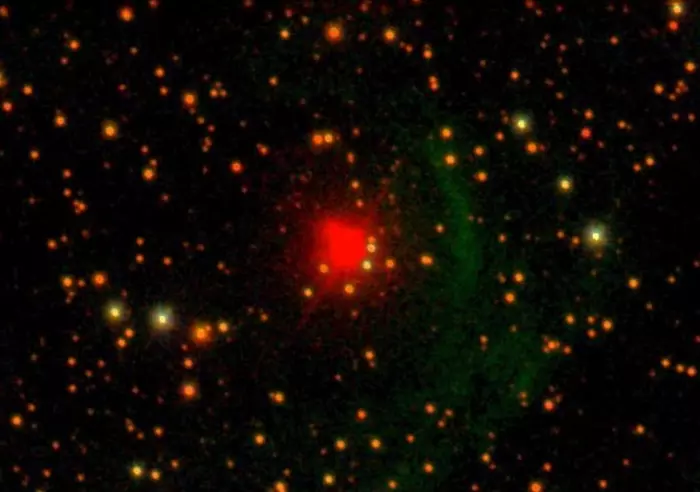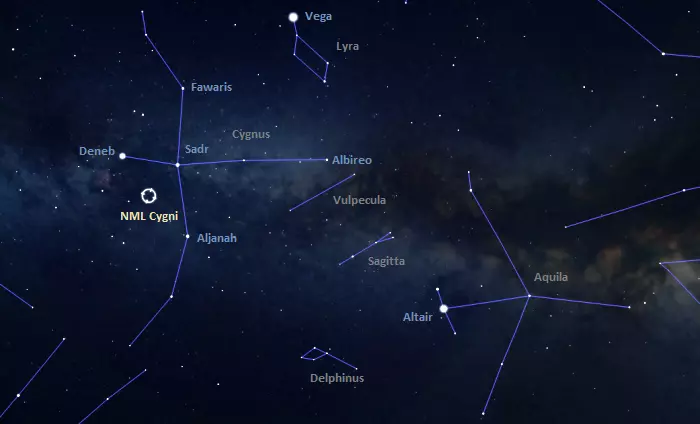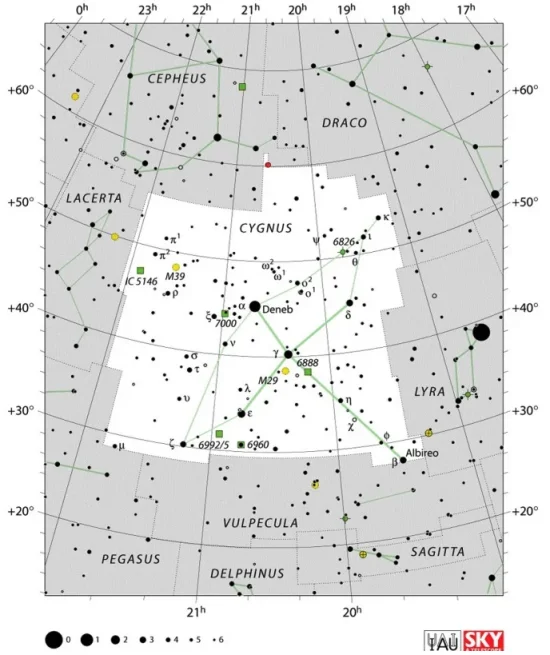NML Cygni is a red hypergiant star located approximately 5,250 light-years away in the northern constellation Cygnus. With an apparent magnitude of 16.60, the star is well below unaided eye visibility. It is one of the largest stars known, with an estimated radius between 1,183 and 2,770 times that of the Sun.
Star type
NML Cygni is a large and luminous red supergiant or red hypergiant of the spectral type M4.5–M7.9 Ia–III. The star’s exact parameters remain uncertain, but NML Cygni is one of the most massive stars of its kind known. It has a mass of about 40 solar masses and a radius between 1,183 and 2,770 solar radii. With a surface temperature of 3,300 K, it is about 229,000 times more luminous than the Sun. The star’s estimated age is only 8 million years.
NML Cygni is one of the most luminous stars in the Milky Way, as well as one of the most luminous and massive cool hypergiant stars. The radius of NML Cygni is comparable to those of the hypergiants VY Canis Majoris, MY Cephei, and AH Scorpii, some of the largest stars known.

This is an image of the bright red supergiant NML Cygni, as viewed by the Sloan Digital Sky Survey Data Release 9. Note the green circumstellar nebula arc surrounding the star. Image credit: Sloan Digital Sky Survey, Apache Point Observatory, Astrophysical Research Consortium
Like VY CMa, NML Cygni has a dusty envelope. The circumstellar shell has a peculiar half-Moon shape. The inner envelope is a source of OH, H2O, and SiO maser emission, while the more extended envelope contains molecules including Co, CO2, HCN, SO, NH3, and HCO+. The asymmetric nebula that surrounds the star coincides with the distribution of H2O vapor masers. The bean-shaped nebula was imaged with the Hubble Space Telescope (HST) Wide Field Planetary Camera 2 (WFPC2) in multiple wavelengths in late 1999 and early 2000.
A spectral survey of the circumstellar envelope of NML Cygni conducted using the Sub-millimeter Telescope (SMT) of the Arizona Radio Observatory (ARO) revealed more than 100 spectral lines from 17 different molecules, including NaCl and AlO, the carbon compounds CO, HCN, HCO+, CN, and HNC, and sulfur and silicon compounds H2S, SO, SO2, SiO, and SiS. The researchers concluded that the 1 mm spectrum of NML Cygni was similar to that of VY Canis Majoris, which suggests that the chemistries of hypergiant stars are similar. The two stars have similar element abundances in their envelopes. The study was led by A. P. Singh at the University of Arizona and published in The Astrophysical Journal Letters in 2021.
Like VY Canis Majoris, VX Sagittarii and AH Scorpii, NML Cygni is an OH/IR star. These are typically red supergiants, hypergiants or asymptotic giant branch (AGB) stars that appear unusually bright in the near-infrared band and show strong OH maser emission. As they reach a late stage in their evolutionary cycle, OH/IR stars develop strong stellar winds and experience enormous mass loss. The gas in the stellar winds speeds away from the stars and condenses as it cools, forming water (H2O) and silicon monoxide (SiO) molecules. As a result, grains of dust are formed (typically silicates) which obscure the stars’ light at shorter wavelengths.
Like other evolved red supergiants, NML Cygni undergoes sporadic mass loss events. The dense envelopes of dust around the star form as a result of a strong stellar wind with a velocity of 23 km/s.
Even though it is a very young star, NML Cygni has evolved quickly due to its high mass. It has burned through its supply of nuclear fuel and is fusing progressively heavier elements in its core. It will meet its end as a supernova in the relatively near future.
NML Cygni is classified as a semiregular variable star of the type SRc. SRc-type stars are variable supergiants of late spectral types that show variations in brightness with amplitudes of about 1 magnitude over periods of 30 days to several thousand days. The brightest examples of this class include Betelgeuse in the constellation Orion, Rasalgethi in Hercules, Herschel’s Garnet Star (Mu Cephei) in Cepheus, CE Tauri in Taurus, T Ceti in Cetus, and VX Sagittarii in Sagittarius. The brightness of NML Cygni varies with a period of either 1,280 or 940 days.
Size
NML Cygni has a radius between 1,183 and 2,770 times that of the Sun. It is one of the largest stars known. If it replaced the Sun at the centre of the solar system, NML Cygni would extend past the orbit of Jupiter (1,114.5 – 1,115.8 R☉) and possibly Saturn (2,047 – 2,049.9 R☉).
The size of NML Cygni was once calculated to be 3,700 times the Sun’s radius with a bolometric luminosity of 500,000 solar luminosities based on a distance of 2 kiloparsecs and an angular diameter of 8.6 milliarcseconds. However, subsequent studies suggested that the star was a regular red supergiant with more modest radius and luminosity values.
More recent estimates yield a distance of 1.6 kiloparsecs, corresponding to a luminosity about 200,000 times that of the Sun.
In 2012, Zhang et al. observed 22 GHz H2O and 43 GHz SiO masers around NML Cygni with the Very Long Baseline Array, a system of ten radio telescopes located across the United States, in order to measure the star’s distance, size, position and kinematics. They found an annual parallax of 0.620 ± 0.047 milliarcseconds, corresponding to a distance of 1.61 parsecs. The proper motion and distance of the star are consistent with membership in the Cygnus OB2 association.
The team found a radio angular diameter of 44 milliarcseconds, indicating an optical angular diameter of about 22 milliarcseconds. They derived a radius of 1,640 solar radii for a temperature of 3,250 K or 2,770 solar radii for a temperature of 2,500 K.
Facts
NML Cygni is a member of the Cygnus OB2 association, one of the nearest massive associations to the solar system. Cygnus OB2 stretches across 2 degrees of the sky and has a physical radius of 30 parsecs. Even though it is over ten times more massive than the Orion Nebula, the Cygnus OB2 group lies behind the Cygnus Rift, a vast dust cloud that obscures and divides the Milky Way’s bright band vertically.
Observations in 1968 led to the discovery of OH masers (1612 MHz) in the star. The studies of the masers later revealed the presence of water (H2O), silicon monoxide (SiO), carbon monoxide (CO), hydrogen cyanide (HCN), carbon monosulfide (CS), sulfur monoxide (SO), sulfur dioxide (SO2), and hydrogen sulfide (H2S) molecules.
NML Cygni was discovered by American astronomers G. Neugebauer, D. E. Martz, and R. B. Leighton in 1965. The three astronomers detected the hypergiant star as part of an infrared survey of the sky carried out at the California Institute of Technology. The discoverers published their findings in The Astrophysical Journal. They reported two exceptionally red and luminous stars whose colour was consistent with a black body temperature of 1,000 kelvin. The other star, a Mira variable in the constellation Taurus, was referred to as NML Tauri for a while but is now commonly known by its variable star designation IK Tauri.
Name
NML Cygni does not have a formal name. The name NML Cygni comes from the initials of the last names of the three American astronomers who discovered the star in 1965, G. Neugebauer, D. E. Martz, and R. B. Leighton.
The star is also referred to by its variable star designation V1489 Cygni but is more commonly known as NML Cygni.
Location
The location of NML Cygni is easy to find, but the star is difficult to spot because it is very faint. It appears roughly halfway between Deneb at the Swan’s tail and Aljanah at its wing.
Deneb and Aljanah are part of the Northern Cross, one of the most identifiable asterisms of the northern sky. The bright Cygnus stars Deneb, Sadr, and Albireo form the pole of the Cross, while Aljanah and Fawaris mark the beam. Deneb is also part of the Summer Triangle, which it forms with the bright Vega in the constellation Lyra and Altair in Aquila.

The location of NML Cygni in the constellation Cygnus image: Stellarium
Constellation
NML Cygni is located in the constellation Cygnus. The celestial Swan is one of the 48 Greek constellations, catalogued by the Greek astronomer Ptolemy in the 2nd century CE. In Greek mythology, it is associated with the god Zeus, who turned himself into a swan to seduce Leda, the queen of Sparta.
Cygnus is the 16th largest constellation in the sky. It stretches across an area of 804 square degrees of the northern sky. It is one of the most recognizable northern constellations. Its five brightest stars – Deneb, Sadr, Aljanah, Fawaris, and Albireo – form the Northern Cross, a bright, large asterism that dominates the evening sky during the northern hemisphere summer.

Cygnus constellation map by IAU and Sky&Telescope magazine
The supergiant Deneb, the brightest star in Cygnus, is the 19th brightest star in the sky. With 19 times the Sun’s mass and 196,000 times its luminosity, it shines at magnitude 1.25 from a distance of 2,615 light-years.
Other notable stars in Cygnus include the supergiant Sadr, surrounded by the emission nebula IC 1318 (the Sadr Region), the contrasting optical double star Albireo, the orange giant Aljanah, the blue giant Fawaris, the luminous blue variable P Cygni, and the Sun-like stars Kepler-22 and Kepler-11, the latter of which hosts six orbiting extrasolar planets.
Cygnus is home to many interesting deep-sky objects that are popular targets for amateur astronomers and astrophotographers. These include the open clusters Messier 29, Messier 39, and NGC 6910, and the Fireworks Galaxy (NGC 6946). The well-known nebulae in the constellation include the Blinking Planetary Nebula (NGC 6826), the Gamma Cygni Nebula (Sadr Region, IC 1318), the North America Nebula (NGC 700), the Pelican Nebula (IC 5070), the Crescent Nebula (NGC 6888), and the supernova remnant known as the Veil Nebula.
The best time of the year to observe the stars and deep sky objects in Cygnus is during the month of September, when the constellation is prominent in the evening sky. The entire constellation is visible from locations north of the latitude 40° S.
The 10 brightest stars in Cygnus are Deneb (Alpha Cyg, mag. 1.25), Sadr (Gamma Cyg, mag. 2.23), Aljanah (Epsilon Cyg, mag. 2.48), Fawaris (Delta Cyg, mag. 2.87), Albireo (Beta Cyg, mag. 2.90), Zeta Cygni (mag. 3.21), Xi Cygni (mag. 3.73), Tau Cygni (mag. 3.65 – 3.75), Iota2 Cygni (mag. 3.77), and Kappa Cygni (mag. 3.814).
NML Cygni
| Spectral class | M4.5–M7.9 Ia–III |
| Variable type | Semiregular variable (SRc) |
| B-V colour index | +2.04 |
| Apparent magnitude (V) | 16.60 (var) |
| Apparent magnitude (K) | 12.3 |
| Apparent magnitude (B) | 18.64 |
| Apparent magnitude (G) | 11.0330 |
| Apparent magnitude (J) | 4.877 |
| Apparent magnitude (H) | 2.389 |
| Distance | 5,250 light-years (4,890 – 5,670 ly); 1,610 parsecs (1,500 – 1,740 pc) |
| Parallax | 0.5279 ± 0.348 mas |
| Proper motion | RA: -1.224 ± 0.344 mas/yr |
| Dec.: -5.595 ± 0.363 mas/yr | |
| Mass | 40 M☉ |
| Luminosity | 229,000 L☉ (188,000 – 269,000 L☉) |
| Radius | 1,639 or 2,770 R☉, 1,183 R☉ |
| Temperature | 3,300 K |
| Age | 8 million years |
| Constellation | Cygnus |
| Right ascension | 20h 46m 25.5392819088s |
| Declination | +40° 06′ 59.464289232″ |
| Names and designations | NML Cygni, NML Cyg, V1489 Cygni, IRC +40448, RAFGL 2650, AAVSO 2042+39, TIC 66995250, 2MASS J20462554+4006594, OH 80.8 -1.9, JP11 5547, Gaia DR2 2065235853217670656, Gaia DR3 2065235853217670656 |